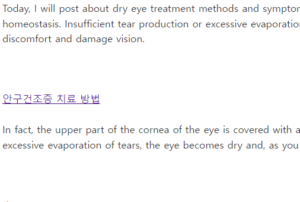안구건조증 치료 방법
Today, I will post about dry eye treatment methods and symptoms. First of all, dry eye syndrome is a disease accompanied by various eye symptoms due to loss of tear film homeostasis. Insufficient tear production or excessive evaporation of tears that cover the cornea can also occur. If moisture is not properly maintained, it can cause eye discomfort and damage vision.
In fact, the upper part of the cornea of the eye is covered with a thin tear film that we are not aware of, but it keeps our eyes moist. If there is insufficient production or excessive evaporation of tears, the eye becomes dry and, as you may have felt, discomfort. Symptoms of dry eye syndrome appear.

dry eye symptoms
Typical examples are: 1. Stiffness in the eyes / 2. Burning sensation / 3. Itching, stinging / 4. Blurred vision / 5. Feeling of sticky tears / 6. Feeling of sand in the eyes and easily fatigued eyes Because of this, I can’t open well, I have to close my eyes to feel comfortable, and when I open my eyes, the symptoms get worse. Especially in winter, when you are out in the cold wind, a lot of tears are secreted, and your eyes look slightly bloodshot.
dry eye causes
1. Decreased tear production
Dry eye syndrome can occur when the lacrimal gland, which plays the most important role in tears, becomes inflamed, insufficiently hydrated, or unable to produce mucin and lipids. There are also physical causes such as aging or going through menopause. Lifestyle habits and diseases such as vitamin A deficiency, long-term contact lens wear, etc. can be the cause.
2. Increased tear evaporation
Rapid evaporation of water, mucus, and oils can also contribute to a lack of tears. In addition, constant exposure to heaters, wind, and dry air in winter, or prolonged computer work can also suppress eye blinking and make your eyes dry.
3. Excessive consumption of alcohol and caffeine
Excessive consumption of alcohol or caffeine can also dry out the mucous membrane of the eyeball and cause poor tear production due to the diuretic action of the lacrimal gland.
4. Overuse of eyes (computer, TV)
There are cases in which the eyes themselves are overworked, such as working while looking at a computer all day, or looking at a cell phone or TV screen without a break when you need to rest your eyes. If it continues, of course, the speed of using tears will increase, and the surface of the ocular mucous membrane will dry out, right?
How to treat dry eye syndrome
1. Use artificial tears (eye drops)
It is one of the most representative and common treatments. The use of artificial tears or eye drops (gel, ointment) that increase eye moisture, which are often prescribed at pharmacies, help maintain moisture in the cornea.
2. Use a humidifier
In particular, if you have severe dry eye syndrome, you may need to use a humidifier to maintain humidity in your home not only in winter but also in summer.
3. Drink plenty of fluids
Of course, tears are water, so hydration is also very important. The act of drinking water is taken for granted and it is easy to neglect it.
4. Give eyes a break in between
If you work on a computer or watch TV or a smartphone a lot, try to reduce the time you spend looking at the monitor, take frequent breaks, and blink your eyes. The same goes for books.
Today, we learned about dry eye treatment methods, symptoms, and causes. Just keep the 4 things I just said above and you can have healthy eyes again without artificial tears. There is no unimportant part of the body, but it is one of the most important parts of the body, so I hope you will recognize the importance of your eyes today and always pay attention to your eye health.